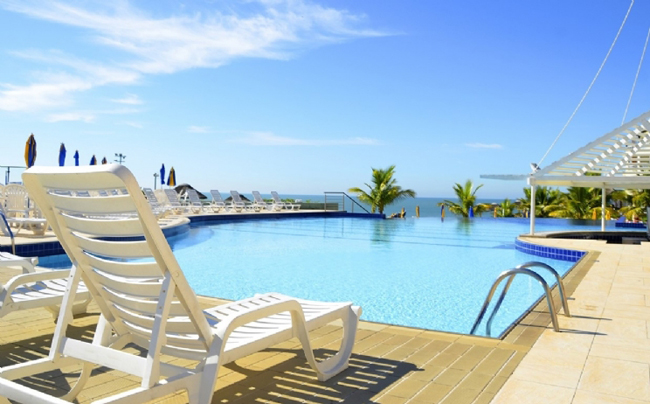
By Mauro Gasparotti
The past year certainly did not disappoint hospitality market stakeholders. Market confidence remained high throughout the year, underpinned by very strong international arrivals growth. This year, not only did we see strong development activities in the main cities and destinations, we also saw secondary and tertiary locations gearing up for development: Ho Tram, Ha Long, Sapa, Quy Nhon to name a few.
Tourism in Vietnam continues to be a promising source of income for the country, with growing demand for accommodation, and many new and promising projects in the pipeline for the next decade. According to the Vietnam National Administration of Tourism (VNAT), in the first 8 months of 2017, Vietnam has welcomed 8,472,379 international tourists, a 29.7% increase over the same period last year with the highest number of visitors coming from China and South Korea. The local demand for travel in 2016 also showed an 8.8% increase of movement of domestic travelers, totaling 62 million travelers, up from 57 million travelers in 2015.
Although the arrivals numbers are impressive, the performance of hotels and resorts across the different submarkets have mostly improved albeit not at the pace that the arrivals numbers would suggest. The last few years have seen robust real estate development activity and today we are beginning to see the implications in terms of new supply. Competition is intensifying across the board and we expect to see more of it going forward, particularly in Nha Trang and Cam Ranh as well as in Da Nang and Phu Quoc. Developers here will need to sober up their performance expectations over the coming years and prepare their pockets for some lean years ahead.
Second home products have been attracting market attention recently: Second home products include branded/non-branded villas, condotel and second home condominium, except pure hotel and resort rooms. As at 8M2017, there are approximately 42 second home properties with more than 9,700 units are operated in Vietnam, offering from affordable to luxury products. It is anticipated that the six coastal destinations (Khanh Hoa, Da Nang, Phu Quoc, Ho Tram, Ha Long & Quang Nam) will witness a huge wave of second home supply of more than 19,200 units in the next 3 years.
Condotel supply accounts for the large proportion of 80% total second home supply in the main coastal destinations (by 2019). Among the main reason why in Vietnam Condotel development are becoming more popular is due to the combination of growing confidence in the hospitality investments associated of developers’ desire of shorter payback Condotel and Second Home is supposedly a “lifestyle product”, which mean buyers are interested in owning an asset that can be used as leisure property. Even if lifestyle product still could potentially offer valid rental return to make this investment more attractive. However, in Vietnam, the Condotel and Second Home products have becomes less perceived as lifestyle products but more as potential for high yield investments. This is due to the larger level to competition within this segment and consequently the way the product have been marketed by the Developer.
In order to incentivize sale, a very popular choice has been to offer a rental guarantee on the product. This common practice offered by some of the largest players has put pressure on smaller developers to offer a similar structure, in order to keep pace with the bigger competitions. We see more and more projects announced, seemingly trying to outdo each other in terms of scale, and outlandish guaranteed returns. These guaranteed products become more risky for buyers when less experienced developers enter into large scale projects with an inadequate amount of equity or not supported by any bank. Developers are quick to label projects as a condotel as soon as they are located in tourism destination but what worries us is the ‘tel’ part of the condotel. In most cases we see the Developers focus on the sales part but very little regard for the hotel part of the project, and all the management implications it entails.
Condotel and Second home products are not able to generate particularly lucrative ROI, this is due to the nature of the product which requires a full operational support to be able to compete with hotel and resort once completed. The typical operating costs of a full serviced Condotel or resort are 45% up to 65% of the gross revenues depending on the facilities and positioning. The expected operating yield highly depending on the price, with smaller more affordable units capable of generating up to 8% of purchasing price and more expensive larger units lowering to 4%-5%. This is highly subject to the market conditions, the usage by the owner and ability of the management company to target profitability. In addition, the majority of the current products are guaranteed only by an SPV created specifically for the project and only in certain cases, the guaranteed returns are backed by a bank. The risk of the condotel model mainly relates to operation after completion. In case the guaranteed return is higher than the achieved cash flow, developers will be obligated to fund additional capital during the guaranteed period in order to deliver on their promises to purchasers. In several cases, the guarantee return is incorporated in the planning stage and reflected into higher selling price in order to cope with the long term return commitment.
In conclusion, this condotel model could be attractive both for buyers and developers but needs to be very well planned by developers and needs a lot of careful analysis before being implemented. Buyers also need to understand the product characteristics and sales policy.


